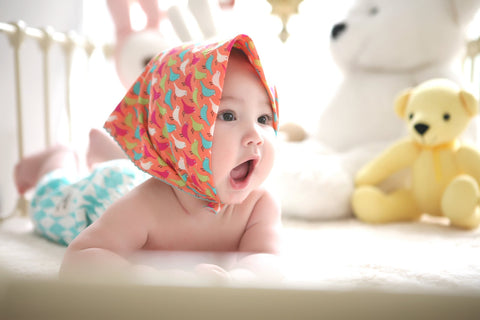By Marilee Joy Mayfield
By the time your baby reaches her first birthday, she is already using her voice to connect with the surrounding environment. Your baby has been babbling for a while, but now you’ll be able to hear strong consonant sounds like p, d, n, or m. Your child will begin repeating and imitating sounds or words that she hears. Short words like “mama, dada, cat, or baby” might be some of the first recognizable words she tries to say. Your baby will understand simple, one-step instructions too, like “please open your mouth.”
By the time your child is 18 months old, he might have a vocabulary of about 20 words. By the age of 24 months, many children have a speaking vocabulary of about 50 words. Your child will start combining words into short phrases like “big dog.” By this age, most children can identify everyday objects in real life and in pictures. If you ask your 2-year-old to show you his eyes, nose, or ears, he should be able to point to them. If you state a two-step instruction like, “please pick up the ball and bring it to me,” he’ll be able to do it.

Your baby is quickly moving from dependent babyhood to independent toddlerhood. This is the time when speaking and reading become connected as related activities. These are also the years of challenges like learning to use the potty, of fears like being scared of monsters in the dark, and of triumphs like riding a tricycle for the first time. Hearing stories about other children going through the same ups and downs of toddler life helps them manage their first powerful emotions.
Reading aloud is vital for your child’s vocabulary and it sets the stage for independent reading skills as your child gets older. As your child becomes more literate, he or she starts to
- Recognize the letters of the alphabet and say them in order
- Understand that those marks on a book’s page are letters that make up words
- Comprehend that words are composed of smaller sounds, which is called phonemic awareness
- Build a sizable vocabulary of words and their meanings
Reading time is a time to bond with and have fun with your toddler. Before naptime, before bedtime, and anytime you and your child are in the mood are all good times to read. Have lots of board books around and let your toddler pick the ones that he or she likes the best. Keep active little hands moving with interesting textures, cutouts, and lift-the-flap pages. Around the age of 2, children can start turning pages by themselves, so it might be a good time to add picture books. Books that have repetition and are easy to memorize are good choices so children can pretend to “read” along. Between the ages of 1 and 2, children will sometimes have favorites that they want read to them over and over again! Read the different characters with different voices and point to the pictures.

Choose books that contain pictures or photos that your child can point to and identify. Letters, colors, shapes, animals, changes in the weather or the seasons are all great topics for this age range. Books about things that kids do every day like baths, mealtime, or bedtime are good choices too. Paying attention to what your child loves, such as trucks, teddy bears, or ballerinas, and finding books that match those interests will ensure that your child looks forward to reading time.
Happy Reading!
|
By Marilee Joy Mayfield Marilee has 15 years experience in education writing fiction and nonfiction for children. Her works have been distributed through Barnes and Noble, Koorong, and Scholastic.
|